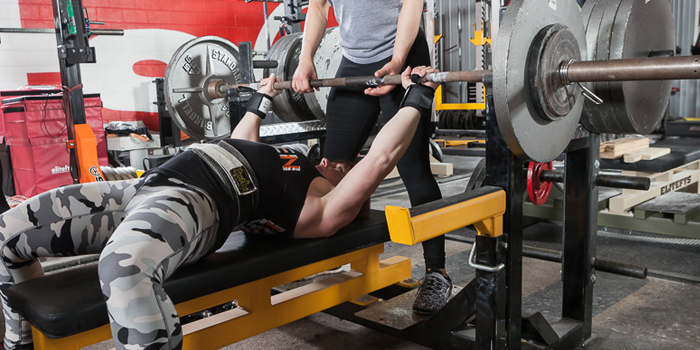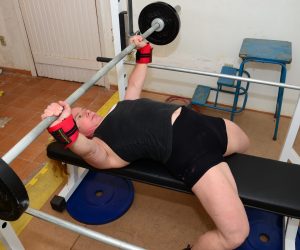
A lift is not exactly “a” movement. It is a complex of movements sometimes called a sport gesture or, for simplicity, a compound movement. A compound movement is just a movement that engages more than one joint. The bench press could be seen as an exercise with more than one compound movement, for example.
A lift is not a simple thing as flexing your elbow; it is a set of motor tasks and it has a learning curve. Like any complex motor task, learning a lift requires a phase of acquiring tacit knowledge. Then, by exhaustive repetition, the most important elements of the lift become automatic (also known as “autonomous” phase) 1.
A sports gesture is not like walking or driving, which are motor tasks that evolve through the cognitive-associative-autonomous phases and the individual can just keep doing it until senile dementia or some brain damage affects it. A sports gesture reaches the autonomous phase and may still degenerate in technique, change (for any reason or combination of reasons) and improve. Also, it can unfortunately reach the autonomous phase with automatic ineffective and mechanically counter-productive movements or positions.
It needs to be fixed.
Fixing a lift is not only for the novice or the mediocre lifter that had the misfortune of learning it from suboptimal sources. No, everyone may need to fix their lifts. The hardest ones to fix are precisely the very high performers. You may not be aware of it, but these are the people who struggle the hardest to fix their lifts. They are already near the top of human performance. Sometimes a one-kilo heavier lift will mean an all-time record. Fixing a ridiculously small issue on the setup or grip may grant him that historical kilo.
RELATED: Strong(her) Bench Press Progressions for the Novice Female Lifter
As in any of the lifts, “fixing” it means solving certain problems. Most problems will fall into the following classes: form or technique (which includes setup and execution), programming (which includes periodization and exercise organization) or injury. Other issues involve mental preparation, nutrition or even the social environment where the lift is being trained.
This series of articles focuses on what, as a coach, I am more qualified to address: form and programming. If chronic injury is the cause for “the problem” (whether it is stagnation or loss of performance), then there are other professionals that can offer better advice than any coach. Psychological and social aspects of performance are extremely important, but addressing them on the same article as technique and programming is confusing. Let’s leave it for another piece.
Assistance exercises address both issues: technique and programming.
Follow me through this series and let’s fix whatever needs to be fixed!
First, let me tell you what you will find in this series and what you will not. “How to fix your bench press” (or deadlift, or squat) or “tips to increase your bench press” (or any other lift) or “add 50 pounds to your bench press” (idem) are powerful titles. How many variations of this articles’ titles have you seen or even read)? Dozens? Hundreds? Yet the same mistakes continue to be made. Apparently, the abundance of articles is not doing that much good to peoples’ lifting. Apart from the fact that tacit knowledge, the type transmitted from experienced practitioner to inexperienced one, is important on learning the lifts, maybe the bloggosphere is lacking in some respect concerning this subject.
Analyzing some of the articles, they fall into three main classes of content:
- Practically useless or even damaging. Contains either irrelevant or outright wrong advice. They usually come from a self-proclaimed online authority, but they may come from a good bencher who has little grasp on the kinesiological aspects of the lift. That comprises about 85% of the online content. Or a little more.
- Useful or even good advice, yet listed with no priority or inserted into a bigger picture of the nature of this specific gesture. It turns out to be a flat and long list of hints that may become useless, since nobody can make use of 25 different suggestions with no specific order. That covers a little more than 10% of the bench press articles or videos out there.
- Advice offered according to a method of movement analysis or methodological approach. That’s where I stand and that’s a minuscule percentage of what is out there.
We’ll start simple and complicate it as we go. Complicating is always easy. Simplifying, though, requires method.
Form or Technique: The Setup
In the greater typology of human movement, the bench press is a “push” movement (I said it would start simple). The main kinetic actions in any pushing movement are focused on triceps extension and shoulder adduction. During the bench press, the pushing action itself (the concentric phase) happens after we manage to get the weight to a “pushable” position: touching the lifter’s chest.
So the first concern about form and technique on the bench is the setup, since neither the descent of the bar (eccentric phase) nor the pushing itself (the concentric phase) will happen efficiently or safely without it.
The setup defines the quality of the gesture. Unlike other common pushing actions in training, the bench press is performed in decubital position. Think about the lifter-barbell structural arrangement: the bar is 2.2 meters long. The weight is at least 27 centimeters away from your index finger, considering a very wide grip. Usually it is even further. You are lying on a bench, with your feet down. As in many other strength and power gestures involving external resistance (objects), the main concern must be the stability of the athlete-barbell arrangement, followed by a mechanically favorable arrangement for the movement, which depends on the levers involved.
1. Scapular Adduction and Proper Bar Support Height
“Stability is the mother of strength” (we’ll get back to this later). The shoulder is an extremely unstable and versatile joint. Bottom line is this: we have an unstable external resistance and an unstable joint, to start with.
The lifter-barbell arrangement reaches its most stable condition when the shoulder’s unnecessary movements are minimized. That implies that the scapulae are adducted and depressed in such a way that shoulder adduction and elbow extension occur in the most possible controlled manner.
The first item of your setup list is, then, scapular adduction and depression, isometrically contracted from start to finish.
The second item of your setup follows the first: the only way to make sure your scapulae are adducted and depressed from start to finish is if the bar is unracked with the least possible involvement of shoulder movements. That requires the bar to be much lower on the support than it usually is (this is actually the first visible mistake one sees in setups even in high performance competitions). The lifter must be able to grip the bar at an elbow angle of more or less 120o, unrack it with a firm elbow extension movement and bring it to a position where scapulae are again depressed (yes, if there is no hand-off by a helper, it is impossible to keep both perfect adduction and depression of scapulae).
The usual unracking of the bar with arms fully extended obviously involves scapular abduction. Doing that with light weight is just very bad and in time will lead to shoulder injury. Doing that with heavy weights is catastrophic.
Step 1: Adduct and depress scapulae. (Squeeze your shoulder blades and pull them down)
Step 2: Unrack the bar with your elbows flexed, with a firm elbow extension and no unnecessary movement with your shoulders.
Pictures courtesy of Marcio Fontana
1.2. The Grip
As with almost everything else, the grip is extremely individual. There is some research suggesting that the mechanically most efficient grip for the bench press is one or another, or even a determined width: 235% of the bi-acromial distance 3,4,5 . This is the result of research conducted according to protocols that do not control for limb proportion or flexibility. What the reality of daily coaching and, more than that, the platform, shows is that this is not a golden number. Which is somewhat predictable, if you think that people with the same bi-acromial distance can have different arm lengths, different spinal flexibility (which partly determines the arch), different fiber composition in primary motor muscles (is the lifter a more “pectoral” or “triceptal” bencher?), different “movement personalities” (whatever that is, but people just prefer certain forms of doing things and that, in powerlifting, does matter a lot), etc.
What should you do then? There is no other way around it: test it. The feedback from the test has to come from:
- The objective information concerning the weight you can handle with a stable concentric movement (how many pounds or kilos can you lift)
- The subjective feeling (do you feel comfortable or “weird”? Does it feel heavier or lighter?)
- External observation of a reliable source: someone who knows what benching is should look at the movement and tell you if it looks stable or not
- Video tape analysis: videotape as much as you can with different grip widths and consider what happens to the movement in general, to your shoulders, to your stability on the bench (which includes loosening or not your scapular adduction – something you DON’T want).
It takes a while to find the “best grip.” Also, many lifters change their grip along the years. Yes, years: not months, not weeks. An injury involving elbows may generate a more stable (or even just possible) narrow grip. A spinal injury may also affect the grip. Finally, familiarity with the lift itself may affect the lifter’s comfort with a wider or narrow grip.
Thumbs around (“regular”) or suicide (“false”) grip? Well, the name has a reason to be: the false grip is related to more accidents. But this article is not about safety; it is about improving performance. Most benchers prefer the regular grip. But if your performance is better with the false grip, the motto “if it ain’t broke, don’t fix it” applies.
Step 3: Grip the bar on your comfort grip and don't change that every workout.
Pictures courtesy of Helena Coutinho
1.3. Glutes, Legs and Feet
We’ve fixed the dorsal stability and the grip. The setup, however, doesn’t stop there if you have control over all your limbs (paralympic lifting, where lifters are usually paraplegic, requires a special bench and the lifter is attached to it with straps). Some of you certainly hear about the famous “leg drive” (poorly explained and not actually researched). Others are still under the impression that the bench press is a “chest exercise." It is not; the squat is not a leg exercise, the bench press is not a chest exercise, and the deadlift is not a back exercise. This typology is what I call “butcher split.” Powerlifting is smarter than that.
We have already shown how dorsal stabilizers as well as the lats (latissimus dorsi)[i] are involved in the setup.
Now it is time to talk about glutes, lower back, legs and feet.
Since setup is about the most stable arrangement of the lifter-barbell system in order for the bench press to happen effectively, we need to understand that there are four points of contact to be considered:
- Hands and barbell
- Dorsal region and bench, both of which we already covered
- Glutes and bench
- Feet and ground.
Those four points of contact define how stable the arrangement is.
Everything is interrelated in every powerlift, but just like the hands-and-barbell points are more dependent on the dorsal-region-and-bench points, the feet-and-ground points are more related to the glutes-and-bench points.
There is no such thing as a good bench press with a soft butt unless you are a paralympic athlete: glutes must be contracted at all times, from setup to lockout. And what happens if your scapulae are adducted and your glutes are contracted? A spinal arch! There you go: this is the physiological explanation for the arch. Even if the lifter is a flat-bencher, some level of spinal arch will exist.
MORE: Fixing Your 'Fail at the Chest' Bench Press
“Oh, but I saw that super heavyweight bench huge weights and there was no arch”. Okay: have you seen an MRI or X-ray of his spine during the lift? No? So you can’t really say if there was a spinal hyper-extension or not, can you? I can tell you there was.
When you contract your glutes, you will also contract your hamstrings (they act together, or synergistically, in the posterior chain). Your feet will probably find their way into the best position.
However, something may get in the way and this order may get messed up. Usually, it is because instead of contracting the glutes, and then hamstrings and then let the feet find their placement on the floor, the lifter squeezes the bench with the hamstring to prepare for the execution. Consequently, the feet may be too close and it will either get the lift to be disqualified because of their placement or, by irradiation (we’ll see that in the following article of this series), the glutes lose contact with the bench (also leading to the disqualification of the lift).
Even if you are not interested in competing, this squeezing of the bench with the thighs upsets the whole balance of levers and usually the lifter also loses dorsal stability.
So this is something that has to be fixed and it starts with learning how to contract the glutes together with scapular adduction to stabilize the lift.
You may need to deliberately spread your feet wider apart as much as possible without losing glute or hamstring contraction.
Step 4: Contract your glutes and keep them like that from setup until racking the bar (end of the lift).
Step 5: Allow your hamstrings to contract according to your glute contraction.
Step 6: Do not squeeze the bench with your thighs instead of contracting the glutes.
Step 7: Spread your feet as wide as you can without losing maximal glute contraction.
Pictures courtesy of Rafael Sato
The movement hasn’t started yet. The bar hasn’t even been unracked. However, the quality of the lift depends on a chain of events that starts with the setup. Starting with the right setup is half-way to excellence on lifting.
In the next article, we will focus on the execution of the bench press.
References and further reading:
DISCLAIMER: Be careful when reading primary research sources. There is something called “sampling”, choice of universe and “n” (size of the sample) that make many research findings hard to apply to an individual athlete’s choices. Things get messier with the experimental protocol choices. More on this later. In doubt, write to us.
- Lee, Timothy Donald; Schmidt, Richard Penrose (1999). Motor control and learning: a behavioral emphasis. Champaign, IL: Human Kinetics. I
- Forthomme, B. et al (2008). Scapular Positioning in Athlete’s Shoulder - Particularities, Clinical Measurements and Implications. Review Article, Sports Medicine, May 2008, Volume 38, Issue 5, pp 369-386
- Barnett, C., Kippers, V., & Turner, P. (1995). Effects of Variations of the Bench Press Exercise on the EMG Activity of Five Shoulder Muscles. The Journal of Strength & Conditioning Research, 9(4), 222-227
- Gomo, O., & Van den Tillaar, R. (2016). The effects of grip width on sticking region in bench press. Journal of sports sciences, Volume 34, Issue 3, 1-7
- Wagner, L.L. et al (1992) International Journal of Sport Biomechanics, 1992, 8, 1-10
[i] Research on latissimus dorsi involvement is controversial and not done with high performance or highly experienced benchers. See: Norwood, J. T., Anderson, G. S., Gaetz, M. B., & Twist, P. W. (2007). Electromyographic activity of the trunk stabilizers during stable and unstable bench press. The Journal of Strength & Conditioning Research, 21(2), 343-347.
Marilia Coutinho is a powerlifter, with world records in full power and on the bench press, having held the all time record for the classic squat. She has a Bachelor's degree in Biology, a MS in Chemical Ecology and a Ph.D. in Sociology of Science, with further education in sports science. She created a continued education program in strength and conditioning under her company MAD Powerlifting.
















With unracking the bar, do you still recommend 120 degree at the elbow to start if one doesn't have a spotter for a lift off?
I appreciate that perfect adduction and depression are not possible without a lift off, but a spotter just is not available for me during training (I train in my home gym alone) so I'm wondering what I can do to get the best set up possible in the circumstances.
Cheers.
You are right: it is impossible to keep scapular depression without a spotter but I still recommend the 120o angle at the elbow.
I know exactly what you feel: I trained a whole competitive cycle completely alone and unracking the heavier weights represents a challenge that frequently causes failure.
The good news is that in the competition you will have a hand-off person and although some people cannot adjust to the new condition, most can and it really feels much easier. Anything that is easier at the competition is one less stress to worry about, righ? :)
No, it is not optimal (to train without a partner). But very few things in life are optimal.
I wish you safe and efficient training and luck at the platform. Let us know if you need any more suggestions.
Marilia
Actually this is one of the most annoying cramps in competitions, when you are not properly hydrated and all.
But once you get used to the proper setup, everything works well!